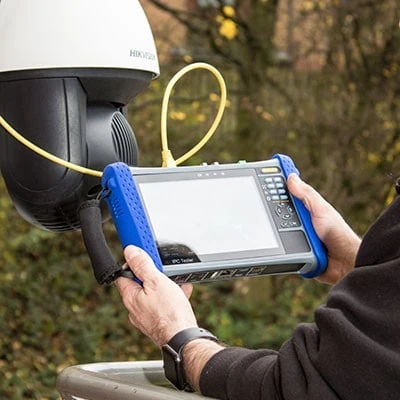Increase in tester use by CCTV installers, reports TREND Networks
TREND Networks is seeing an increasing number of CCTV installation firms using a new breed of tester to eliminate guess work when installing CCTV systems. The testers help to maximise video quality, provide proof of installation and generate detailed reports for the end user.
“With the goals of deterring crime, preventing fraud and capturing valuable evidence when a security event occurs, high-quality CCTV footage from dependable installations should not be taken for granted,” says Dan Barrera, Global Product Manager, TREND Networks.
Factors that impact the networks which support CCTV are the number of cameras, resolution, frame rate and compression CODEC. Designers of CCTV networks must balance video quality with network performance, and they rely on the integrators/installers of the system to configure the cameras according to the specification.
“All too often the end-user of the CCTV system is dissatisfied with the video performance or quality,” he says. “Designers and installers can often disagree over the root cause.”
TREND Networks launched SecuriTEST IP in 2018 and has seen exponential demand across the world. The tester enables technicians to install, test, troubleshoot and document IP/digital, HD coax and analogue CCTV camera systems with a single tester.
Its 7-inch, hi-res touchscreen and simple to use functions ensures just one tester is needed, even on complex installations. For example, SecuriTEST IP can be connected quickly and easily to IP or analogue cameras with in-built RJ45, Wi-Fi and BNC ports.
SecuriTEST IP allows users to access camera settings and adjust parameters while monitoring the video stream bandwidth in real-time to see the effects of their changes. Technicians can ensure that each camera is configured to provide the video quality required for a specific location whilst minimising bandwidth impacts on the network.
For example, the advantage of high-resolution CCTV cameras is that a single camera with a wide-angle lens can be used to survey large areas like car parks where several low-res cameras would normally be required, allowing for simplified installations, reduced labour costs and better image detail when enlarged.
“The higher the resolution, the more data that needs to be transported by the network, which may cause problems,” he says. “Similarly, one of the most common complaints from users of IP CCTV is stuttering video, especially if they are accustomed to analogue video with a rate of 25-30 FPS (frames per second). A higher FPS results in smoother, natural looking video. In contrast, the default frame rate for most IP cameras is 10 or 15 FPS to reduce network load.”
To achieve the smooth real-time video that end-users expect, an NVR/NAS with a 1Gb/s interface could support about 30, 4K UHD 30 FPS cameras at most to keep the combined bandwidth under 70% of the link rate.
Compression is another factor and nearly all IP CCTV cameras support MJPEG (motion JPEG) and H.264, with manufacturers beginning to ship camera models that also support H.265 compression.
“With MJPEG video each frame is a full resolution image which provides the best video quality, but it has a huge impact on network bandwidth,” he explains. H.264 and H.265 are versions of MPEG compression which works by transmitting a complete frame (key-frame or I-frame) with several change-frames in between. The change-frames show only information that is different from the key-frame.
Before SecuriTEST IP was launched, CCTV installers would use an assortment of tools to troubleshoot and provide proof of installation. These would include PoE injectors to power the camera, battery for the injector, a laptop with special software to connect to the camera and to see the video for aiming, wire map checkers for troubleshooting cable problems and other assorted devices.
“With the various tools previously used, there was still no way to document the installation with professional looking reports. Until now,” he says. “The main reasons to document camera setup at installation are to show that the camera is aimed and focused at the prescribed location, it is the correct resolution, has the desired frame rate and CODEC set and has the correct network configuration,” explains Dan.
“Complete documentation also reduces service time because the report from a dead camera can be used to configure the replacement with the same network and video settings so it can be swapped out with minimal disruption.”
To learn more about SecuriTEST IP, visit www.trend-networks.com
![Increase in tester use by CCTV installers, reports [CompanyName] 1 securitest ip](https://www.trend-networks.com/wp-content/uploads/2019/11/securitest-ip.jpg)




